The Destemmer Machine Market is estimated to be valued at USD 989.3 million in 2025 and is projected to reach USD 1658.1 million by 2035, registering a compound annual growth rate (CAGR) of 5.3% over the forecast period.
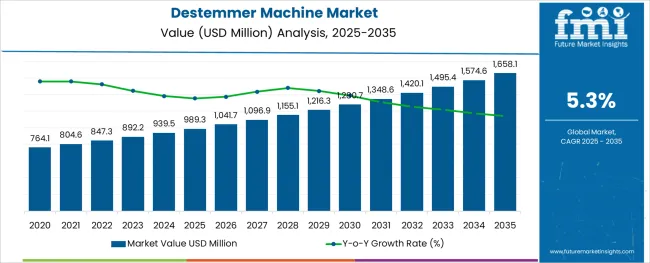
The destemmer machine market is advancing steadily as wineries and grape processing units increasingly focus on operational efficiency, product quality, and sustainability. Growing consumer demand for premium wines and stricter quality standards have intensified the adoption of advanced destemming solutions to minimize grape damage and enhance juice extraction.
Industry trends indicate that innovation in machine design, such as adjustable settings for various grape varieties and reduced maintenance requirements, is strengthening market appeal. Future growth is anticipated to be fueled by expansion of medium and small-scale wineries, the modernization of vineyards, and rising investments in automation within the wine production process.
Demand is also being influenced by the need to reduce labor dependency and improve consistency in grape processing, paving the way for greater adoption across diverse production scales.
The market is segmented by Product Type, End-use Industry, and Distribution Channel and region. By Product Type, the market is divided into Destemmer-Crusher, Destemmer, and Crusher-Destemmer. In terms of End-use Industry, the market is classified into Medium-scale, Small-scale, and High-scale. Based on Distribution Channel, the market is segmented into Specialist Retailer, Supermarket/Hypermarket, and Online Retail. Regionally, the market is classified into North America, Latin America, Western Europe, Eastern Europe, Balkan & Baltic Countries, Russia & Belarus, Central Asia, East Asia, South Asia & Pacific, and the Middle East & Africa.
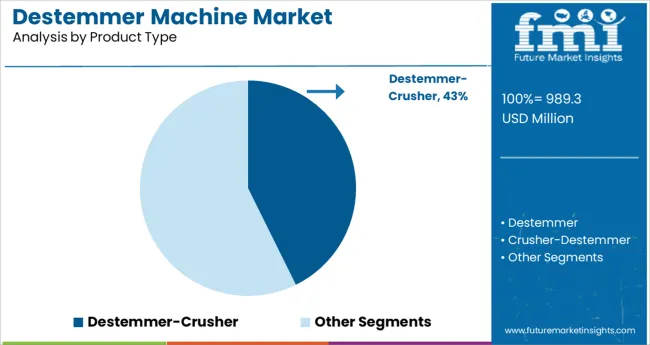
When segmented by product type, the destemmer crusher segment is expected to hold 42.7% of the total market revenue in 2025, establishing itself as the leading product type. This dominance has been driven by its dual functionality of separating stems and crushing grapes in a single pass, which significantly reduces processing time and labor effort.
The compact and efficient design of these machines has enabled wineries to optimize space utilization while maintaining high throughput. The ability to adjust crushing intensity to suit different grape varieties and desired wine styles has further reinforced its adoption.
Enhanced durability, lower operational costs, and the capacity to produce cleaner must have positioned the destemmer crusher as the preferred choice for producers seeking both quality and efficiency in grape processing.
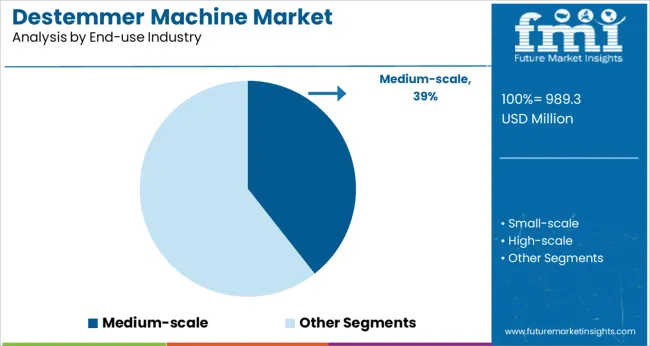
Segmented by end use industry, medium scale operations are projected to account for 39.4% of the destemmer machine market revenue in 2025, maintaining their leadership position. This leadership has been underpinned by the increasing number of regional and boutique wineries that require efficient yet affordable machinery to compete with larger producers.
Medium scale enterprises have shown a strong inclination toward upgrading traditional methods with automated solutions to enhance productivity and maintain consistent product quality. The balance between capacity and investment cost offered by destemmer machines aligns well with the operational needs of this segment.
Their flexibility in adapting to seasonal production volumes and diverse grape varieties has further driven preference for such equipment, solidifying the medium scale segment’s prominence in the market.
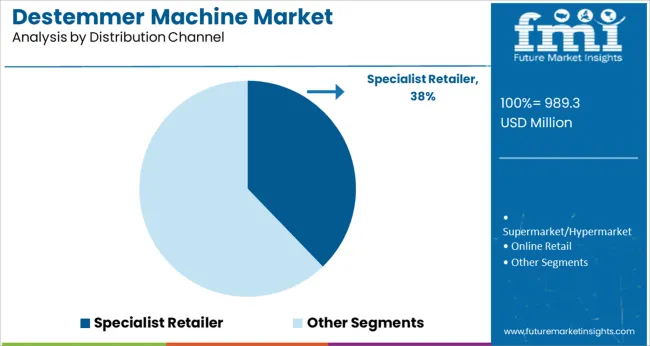
When segmented by distribution channel, specialist retailers are forecast to capture 37.8% of the market revenue in 2025, securing their position as the leading channel. This prominence has been attributed to their deep understanding of winery requirements, ability to offer tailored solutions, and provision of aftersales support and maintenance services.
Specialist retailers have effectively built trust with buyers by offering demonstrations, technical guidance, and customized configurations suited to specific production needs. Their role in educating buyers about new technologies and helping them navigate purchase decisions has been instrumental in driving adoption.
The presence of established relationships within wine producing regions and a focus on premium service quality have further strengthened specialist retailers’ dominance in the distribution landscape.
The global market for destemmer machine increased from USD 764.1 million to USD 847.3 million between 2020 and 2025 with a CAGR of 5.1%.
The market for destemmer machines is expected to grow in the future as the demand for wine increases. However, historical data shows that the market has been volatile, with sales declining during economic downturns. Based on this research, we can project that the destemmer machine market is likely to continue to be volatile in the future. However, overall, we expect that the market will grow as the demand for wine increases.
During the forecast period, the global destemmer machine market is anticipated to grow from USD 989.3 billion in 2025 to USD 1,495.4 billion by 2035 with a healthy CAGR of 5.3%.
The Rise in Wine Consumption
The escalating trend among the population in regards to drinking wine in bars, restaurants, nightclubs, and other forms of entertainment is propelling the demand for wine from such end users, which, in turn, is driving the demand for destemmer machines.
For instance, according to the Future Market Insights analysis, the consumption of wine in the world was 226 hectolitres and it went up to 242 hectolitres according to the analysis. Due to the increasing consumption of wine across the globe, the market is expected to grow at a positive pace in the coming years.
Additionally, as consumer disposable income rises, it is expected that the demand for wine will increase since this drink represents a status symbol to many consumers. In the USA, for example, according to the Bureau of Economic Analysis, disposable personal income in February 2020 was USD 764.1 billion, while it is predicted to reach USD 14809.91 billion in March 2020.
As a result, there has been an increase in usage of these products for celebrations, anniversaries, parties, social gatherings, personal moments, and many more, which have all played a part in fueling the growth of the market.
Incorporating Wine into Food and Beverages Products
The growing use of wine in food and beverage products is expected to generate opportunities for market growth. A high prevalence of cancer is one of the factors that has been responsible for a proportional increase in the use of wine in food and beverages, due to its presence of the compound called resveratrol, which can cause cancer cells to be destroyed.
It has also been found that resveratrol may assist the body in protecting itself against bacteria such as Helicobacter pylori and Chlamydia trachomatis. In addition to its antibacterial properties, wine also has anti-cancerous properties, which can decrease the risk that an individual may develop cancer in the future.
Statistically, according to the cancer.gov analysis, there were 1,685,210 new cancer cases registered in the United States, and it climbed to 1,735,350 the following year, with the number of cancer-related deaths reaching 609,640 that year in the United States.
The consumption of grape wine is expected to provide a growth opportunity to the market in the near future as a consequence of the reduction of the death rate of cancer, which inadvertently leads to an increase in the consumption of grape wine in foods and drinks.
The Crusher Destemmers Segment Accounts for Leading the Global Destemmer Market
In small-scale industries such as winemaking at home, crusher destemmers are used because they are comparatively less expensive. The destemmers that are used in this type of process crush the grape bunches at the first level and then separate the stems from the bunches, which has the disadvantage of passing the stems through the fermenting process before the fermenting process gets started.
There are several stages involved in making wines and each stage requires different knowledge and skills. In addition, some winemakers are also farmers who grow their grapes to make wine. According to these wine producers, crusher destemmers are the most cost-effective solution to destem wine compared to other alternatives.
It is because good grapes combined with small-scale fermentations and smart cellar practices produce compelling and interesting wines that this equipment is finding a wide-scale application, as grapes are the basis of wine production. Crushing grapes or fruit before the primary fermentation helps to break down the fruit pulp and allows the juice to flow out. This allows the juice to ferment, which drives the demand for crusher destemmer.
Most destemmers are used in high-volume wine production in the wine industry. When it comes to processing large quantities of grapes, destemmers can save a great deal of time and labor. Also, destemmers can contribute to the improvement of the quality of the wine by removing any impurities or debris from the grapes before they are pressed, which can enhance the taste of the wine. Also, stemmers are used in many other fields, such as in the food industry, but they do not appear to be as common as they are in the wine industry.
When it comes to buying Destemmer Machines, consumers prefer specialist shops. When it comes to this product, these stores have a wealth of knowledge and experience. In addition to offering a better selection of machines, specialist stores are more likely to provide customers with a more personalized service that is suited to their needs and requirements.
A specialist store usually gets to know its customers and builds up a rapport with them, something that big box stores are not able to do. In addition, specialist stores usually have a wider range of products on offer, so consumers are more likely to be able to find the perfect machine for them when visiting a specialty store.
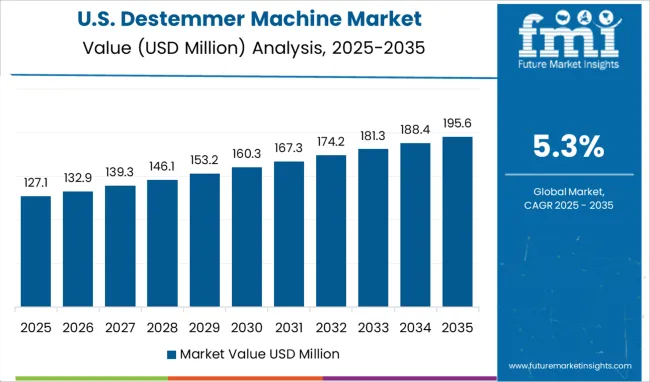
There is a strong prediction that North America may be the dominant region for the next couple of years due to rising consumer awareness about high-quality, healthy, and nutritional wines, the surge in the number of young wine connoisseurs, and an increase in personal disposable income.
In this region, the market is growing due to changes in lifestyle, increased penetration of e-commerce platforms, an increase in supermarkets and department stores, an increase in awareness about the benefits of consuming wine, and an increase in restaurants, lounges, and recreational clubs.
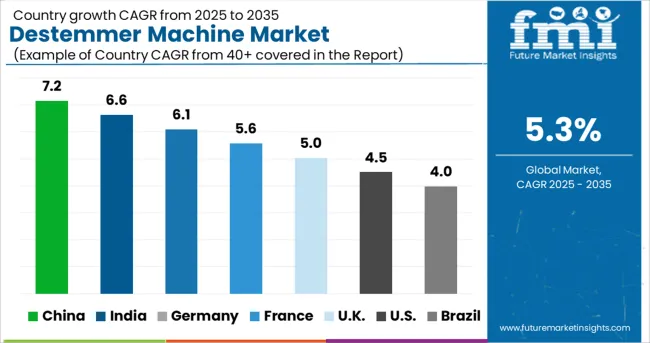
The USA accounted for 35.8% of the Global market with a value of USD 989.3 million in 2025. The destemmer machine market in the United States is evolving at a rapid pace. From January through August 2025, the USA imported a total of 52,494 cases of wine from Portugal's central-southern Alentejo region, which registered a volume increase of 12.7% and a value increase of 31.9%. The Portuguese National Institute of Statistics reports that imports and exports of wine are increasing with volume growth of 11.5% and value growth of 26.6% over the past three years.
With an average SRP of USD 11, 42 producers were exporting 1,528,183 liters of wine to the USA In 2024, there were 57,517 acres/23,277 hectares of land used for the planting of wine grapes which was a significant increase of approximately 21% over the last ten years, which is a reason why the USA wine industry is thriving.
The United Kingdom Destemmer Machine Market will grow at 6.5% CAGR between 2025 and 2035. The United Kingdom is the largest market for Destemmer Machines in Europe. The demand for Destemmer Machines is driven by the growing wine industry in the country. The United Kingdom has a thriving wine industry with exports. The United Kingdom's market share in destemmer machines is expected to grow in the future as more companies enter the market and demand for the machines increases.
The India Destemmer Machine Market will grow at 6.0% CAGR between 2025 and 2035. In India, the Destemmer Machine market is growing at a rapid pace. Key players in the market are investing in research and development to offer innovative products. The Indian government is also providing subsidies and tax benefits to encourage the growth of the industry.
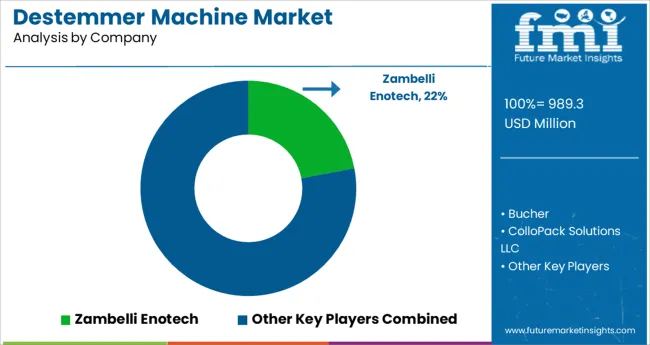
The Destemmer Machine market is highly competitive with numerous players vying for a share of the pie. The leading players in the market include Bucher Industries, Zambelli Enotech, and ColloPack Solutions LLC. These companies have been in the business for many years and have a strong hold on the market.
The companies in the Destemmer Machine market are constantly innovating and introducing new features in their products to stay ahead of the competition. They are also investing heavily in marketing and promotion to create awareness about their products among consumers. There are several established participants in the industry and local manufacturers. Hence, the market is fragmented with multiple players:
Recent Developments
| Attribute | Details |
|---|---|
| Forecast Period | 2025 to 2035 |
| Historical Data Available for | 2020 to 2025 |
| Market Analysis | million for Value and Units for Volume |
| Key Regions Covered | North America; Latin America; Europe; The Middle East and Africa; East Asia |
| Key Countries Covered | USA, Mexico, Canada, United Kingdom, Germany, France, Italy, China, Spain, India, Japan, South Korea, Australia, Argentina, Brazil, South Africa, UAE |
| Key Segments Covered | Product Type, End-uses Industries, Distribution Channel, Region |
| Key Companies Profiled | Zambelli Enotech; Bucher; ColloPack Solutions LLC,; Scott Laboratories Inc; Scharfenberger GmbH & Co. KG; Winequip; Criveller Group,; BrewcraftUSA; PERA-PELLENC S.A; ENOITALIA SRL; ENOTECNICA PILLAN SRL; CMA; Diemme; Zenit |
| Report Coverage | Company Share Analysis, DROT Analysis, Market Dynamics and Challenges, Strategic Growth Initiatives, Market Forecast, Competitive Landscape, |
| Customization & Pricing | Available upon Request |
The global destemmer machine market is estimated to be valued at USD 989.3 million in 2025.
It is projected to reach USD 1,658.1 million by 2035.
The market is expected to grow at a 5.3% CAGR between 2025 and 2035.
The key product types are destemmer-crusher, destemmer and crusher-destemmer.
medium-scale segment is expected to dominate with a 39.4% industry share in 2025.






Full Research Suite comprises of:
Market outlook & trends analysis
Interviews & case studies
Strategic recommendations
Vendor profiles & capabilities analysis
5-year forecasts
8 regions and 60+ country-level data splits
Market segment data splits
12 months of continuous data updates
DELIVERED AS:
PDF EXCEL ONLINE
Destemmer Market
Wine Destemmer Market - Growth & Demand 2025 to 2035
Machine Glazed Paper Market Size and Share Forecast Outlook 2025 to 2035
Machine Glazed Kraft Paper Market Forecast and Outlook 2025 to 2035
Machine Condition Monitoring Market Size and Share Forecast Outlook 2025 to 2035
Machine Glazed Paper Industry Analysis in Asia Pacific Forecast Outlook 2025 to 2035
Machine Vision Camera Market Size and Share Forecast Outlook 2025 to 2035
Machine Tool Oils Market Size and Share Forecast Outlook 2025 to 2035
Machine Vision System And Services Market Size and Share Forecast Outlook 2025 to 2035
Machine Glazed Paper Industry Analysis in Western Europe Size and Share Forecast Outlook 2025 to 2035
Machine Glazed Paper Industry Analysis in Korea Size and Share Forecast Outlook 2025 to 2035
Machine Glazed Paper Industry Analysis in Japan Size and Share Forecast Outlook 2025 to 2035
Machine Tool Cooling System Market Analysis - Size, Share, and Forecast Outlook 2025 to 2035
Machine Tool Touch Probe Market Analysis - Size, Growth, and Forecast 2025 to 2035
Machine Mount Market Analysis - Size & Industry Trends 2025 to 2035
Machine Control System Market Growth – Trends & Forecast 2025 to 2035
Machine Automation Controller Market Growth – Trends & Forecast 2025 to 2035
Machine-to-Machine (M2M) Connections Market – IoT & Smart Devices 2025 to 2035
Machine Safety Market Analysis by Component, Industry, and Region Through 2035
Key Players & Market Share in Machine Glazed Paper Industry

Thank you!
You will receive an email from our Business Development Manager. Please be sure to check your SPAM/JUNK folder too.
Chat With
MaRIA